Segment Creator
The Segment Creator now allows you to create segments from the VWO Engage (formerly PushCrew) Dashboard itself. The "Segment Creator" User Interface allows you to create segments using subscriber properties, page visit & click events with conditional statements and logical operators i.e., "AND" and "OR". These elements are explained in the section below.
The First section of segmentation i.e, segmentation based on Subscriber Properties feature is available to all customers in Premium, Business, and Enterprise plans. It is also available from the trial plans as well. Although the second section i.e, segmentation based on Page visits & click events is only available for Business and Enterprise Plans
The steps below explain how to implement the Segment Creator feature:
1) Click on the "Segments" tab from your VWO Engage dashboard. If you have already created a set of segments using JS/REST APIs, it would be listed as shown.
2) Click on Create to start creating a new Segment.
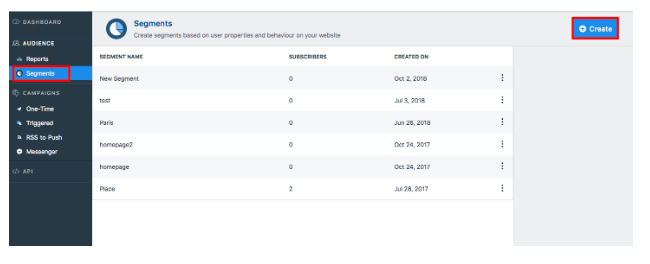
3) Now you have 5 types of "Subscriber Properties" based on which you can segment your customers. They are Operating System, Platform, Browser, User Agent, and Location as shown in the screenshot below. These subscriber properties are the first section of segmentation, the second section is discussed below.
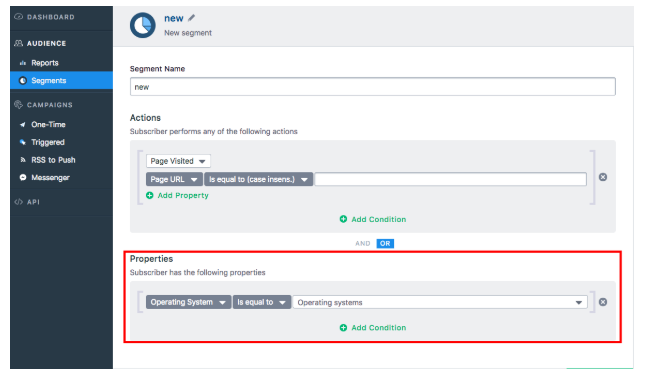
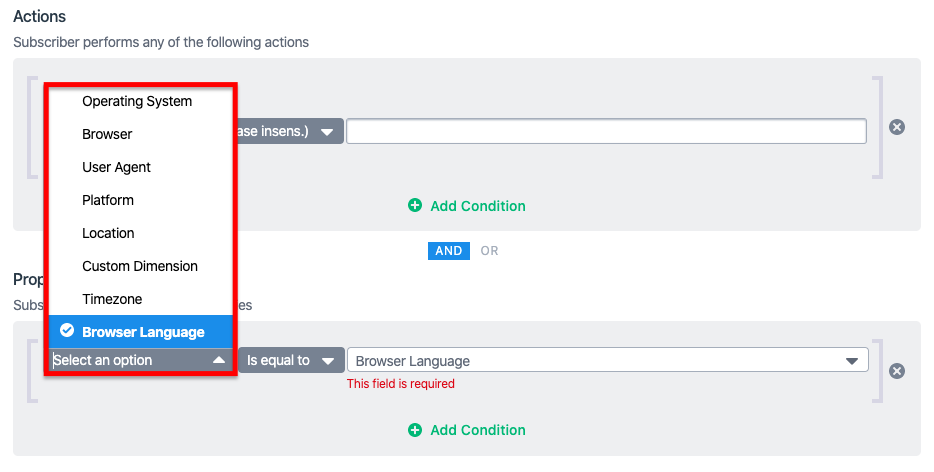
4) The two types of conditional operators that are available are "Is equal to" and "Is not equal to".
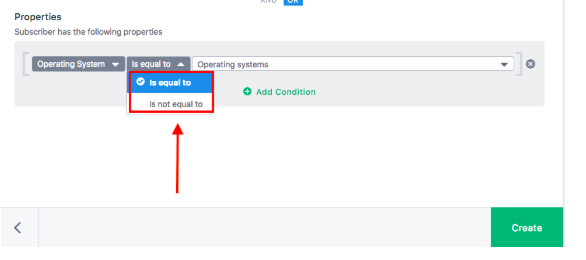
5) Each Subscriber Property has its own sub-divisional properties.
a) Operating System - Segmentation can be based on Windows, Mac OS, and Linux

b) Browser - Chrome, Firefox, Safari, Opera, Edge, Samsung Internet Browser, UC Browser
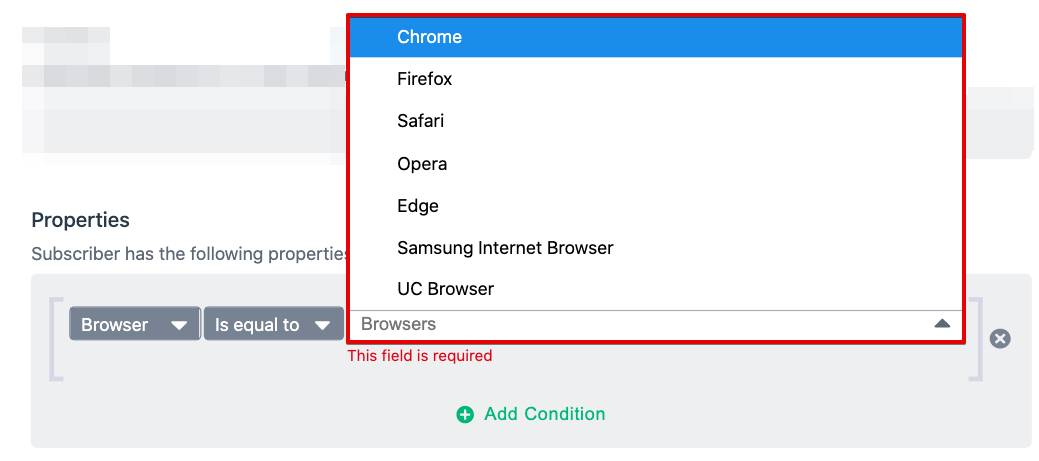
c) User Agent - This is a special kind of Subscriber property which has following conditional properties as shown. This property serves unique needs of segmentation wherein you can create custom logic from the subscriber property of a visitor. For example, if you want to segment users based on the model of a mobile device that they are using, custom code can be written for the same.
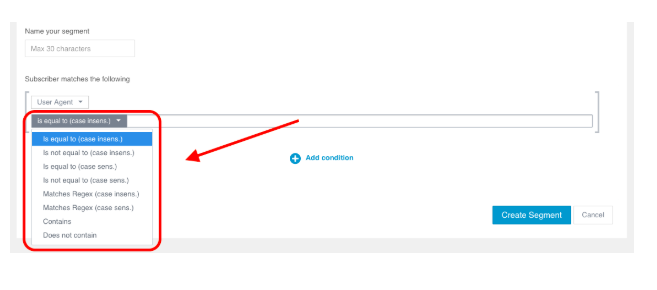
For example, If you want to segment users who use Samsung Galaxy S8 Phone, Select "contains" and type in the user agent for the same as shown. It will group all the subscribers which subscribed using Samsung Galaxy S8 in the segment "Samsung S8"
d) Platform - Desktop or Mobile devices
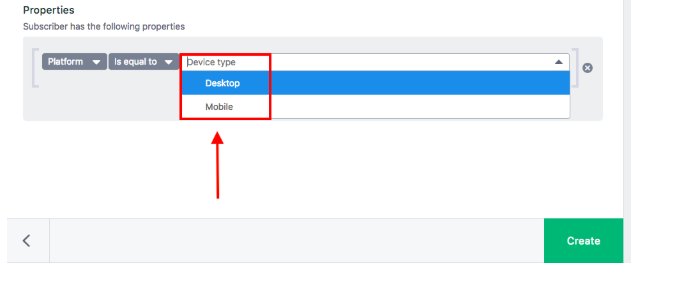 e) e) Location - The Location-based segmentation can be from the country level to city level.
e) e) Location - The Location-based segmentation can be from the country level to city level.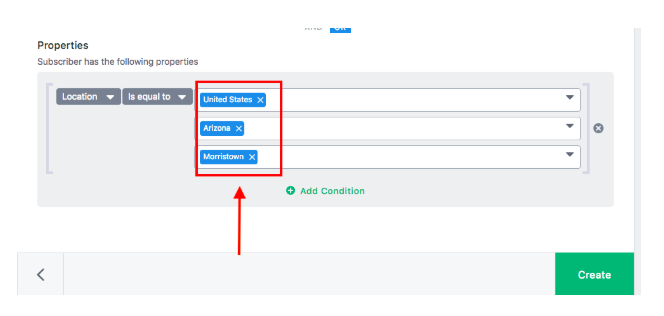
f) Timezone - If you wish to prioritize the users based on their timezone and send out the notifications to them, choose this option. Here, you can choose one or more timezones from the dropdown list to target different timezones. For example, if you want to send out the notifications to the users residing in different timezones of the USA, you can create a segment by specifying all the required timezones from the dropdown list.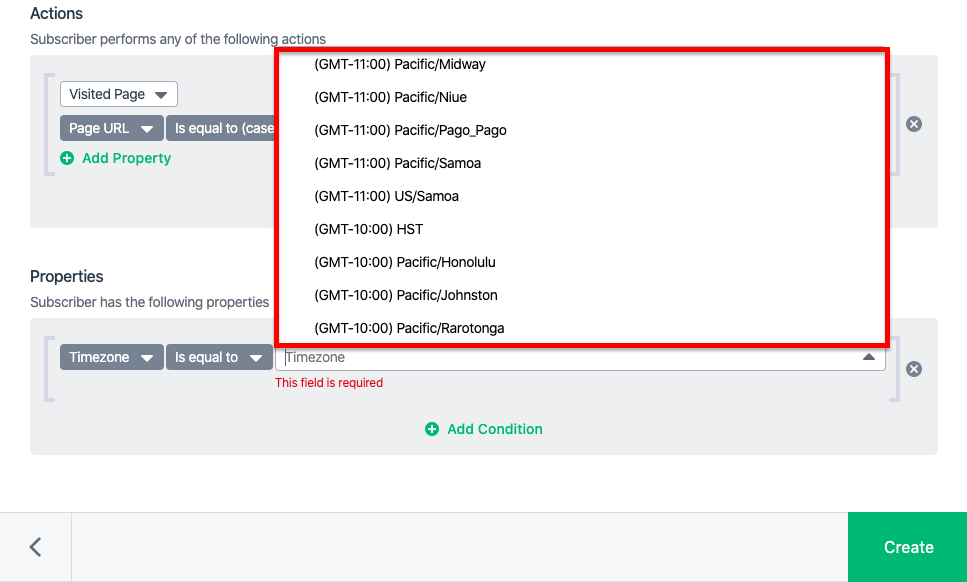
For the Timezone property, two conditional operators are available- is equal to and is not equal to.
g) Browser Language - There are situations where you want to send out the notifications to the users based on their browser language rather than the language which is prominent in their country. For example, a user working in the USA is using Chinese as his/her browser language. Using the Browser Language option, you can create a segment that targets sending out the notifications to the users in the Chinese language.
Here, you can specify one or more Browser Languages from the dropdown list to target users based on their browser language. As of now, 38 languages are supported For the Browser Language property, two conditional operators are available- is equal to and is not equal to.
You can use multiple conditions to create your segment which can be a combination of "AND", "OR" and brackets as shown.
The below condition for segment implies that either [indian susbcribers] or [United States subscriber who uses Windows OS] are segmented under the segment name "Ind-or-US-using-Windows"

The function of bracket changes the logic altogether i.e., as per the below example which implies that either [Indian or the United States susbcribers] who use Windows. The brackets can be used by clicking on the brackets and highlighting their starting and ending point as shown below (highlighted brackets are dark gray in color).
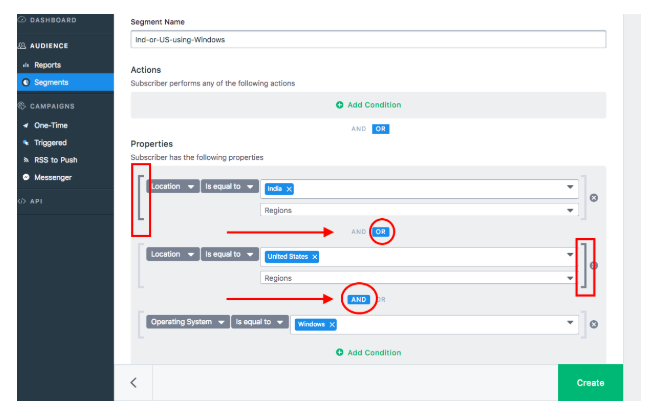
NOTE: The segment creator's logic is as follows, it checks whether the condition has a bracket. If yes it evaluates the logic inside the bracket first and moves to the logical operators i.e., "AND" or "OR". If there is no bracket in the logic, it evaluates AND operator first and then OR operator.
7) The second section is segmentation based on the visitor's action - Page visited. The following are the types of segmentation of Page visits - URL, Referring URL, Search Keywords, Referral Type, Query Parameters as shown below.
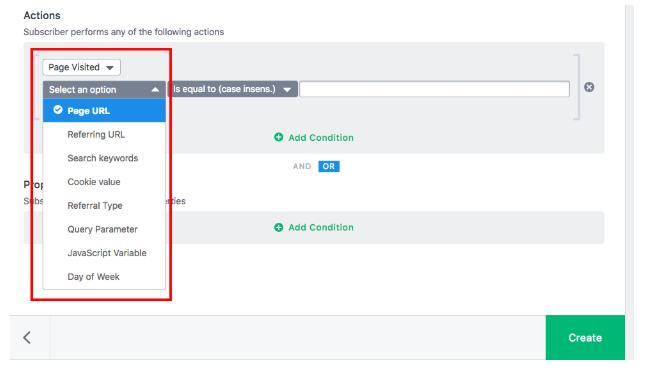
a) Page URL - A Page URL can be provided and the subscribers will be segmented when he/she visits that page. The below listed are the types of conditions available.
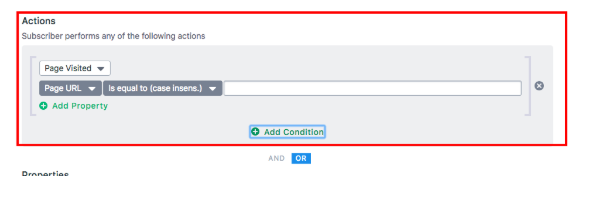
b) Referring URL - The URL from which the visitors are coming over to your website can be provided here and based on which the subscribers are segmented. These are basically Upstream links to your site.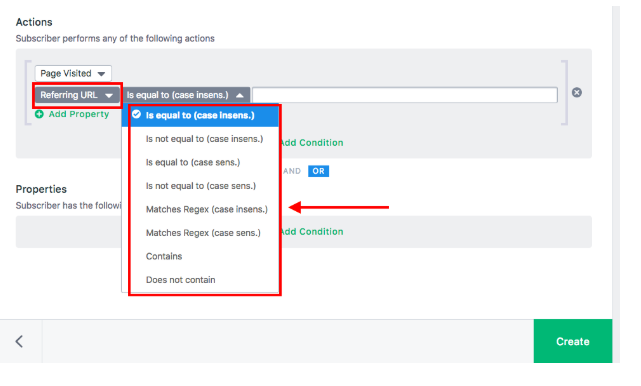 c) Search Keywords - The search keywords through which visitors are coming over to your site can be given as input and based on which segment would be created. The search engines that we support are Search.com, AOL and Baidu.
c) Search Keywords - The search keywords through which visitors are coming over to your site can be given as input and based on which segment would be created. The search engines that we support are Search.com, AOL and Baidu.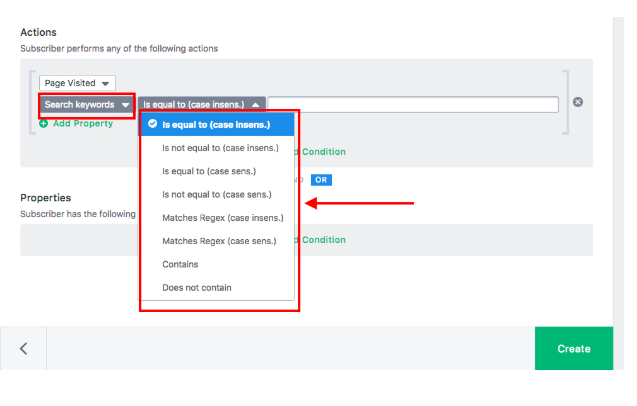
d) Cookie Value - Using this, you can segment users based on the cookies name and value pair stored by your website on user’s browser.
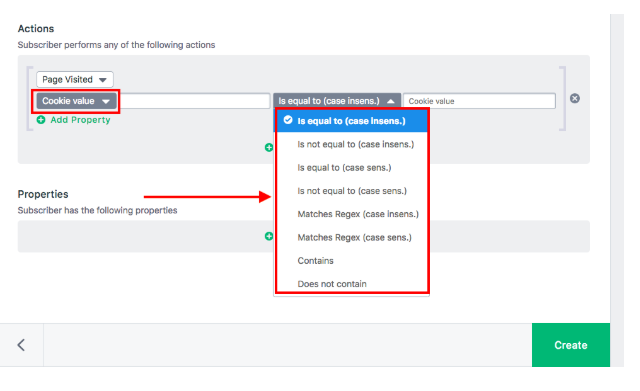
For example, as shown below subscribers are segmented based on the cookies which contain a particular name-value pair - users for whom the cookie filter_name contains open.

e) Referral Type - Using this, you can segment users based on how the visitors landed on your site. The following are the referral type categories
> Direct - A visitor coming on to your site directly by typing your website URL
> Search Organic - A visitor coming on to your site through a search engine. For example, Google.
> Referred - A visitor coming on to your site from another external website

e) Query Parameter - Using this, you can segment users based on query parameter present in the link.

For example, as shown below subscribers are segmented based on the query parameter containing Facebook.

f) JavaScript Variable - Using this, you can segment users based on the JavaScript variables present on your website

For example, as shown below subscribers are segmented based on the value of a particular JavaScript variable - users who chose apartment_type as 2BHK.

h) Day of the week - Using this, you can segment users based on which day of the week he/she visited on your website.

For example, as shown below subscribers are segmented based on the value of a particular Day of the week - users who visited on a weekend.

i) Hour of the Day - Using this, you can segment users based on which hour of the day he/she visited on your website.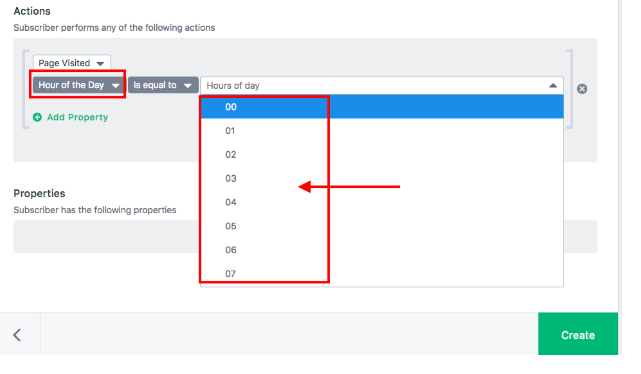
For example, as shown below subscribers are segmented based on the value of a particular Day of the week - users who did not visit in the evening (between the hours 17,18,19 and 20:59).
NOTE:
1) The Page visit segmentation feature goes into action once the segment is created and henceforth the subscribers would be added whereas, the previous section of the segmentation can segment the subscribers based on the existing data about the subscribers.
2) There is only OR Operator between Page Visit Conditions and bracketing is not possible for Page visit segmentation.
3) You can combine the subscriber property segmentation and page visit segmentation. for example, the below screenshot shows the segment of subscribers coming on the VWO Engage blog page using windows OS and the subscribers are from New Delhi in India.
8) Segmentation based on Click events
The segment creator also allows you to segment subscribers based on the elements (buttons, text, images, videos, etc) clicked by your subscriber. All you need to do is specify the CSS selector path of the element to track as shown below:
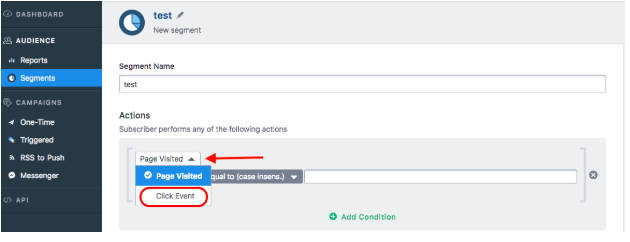
How do I find a CSS path of an element?
a) Google Chrome
- Right-click on the element you want to track and select Inspect Element. The developer tool display with the element properties
- Right-click on the element property and select Copy and then click Copy Selector.
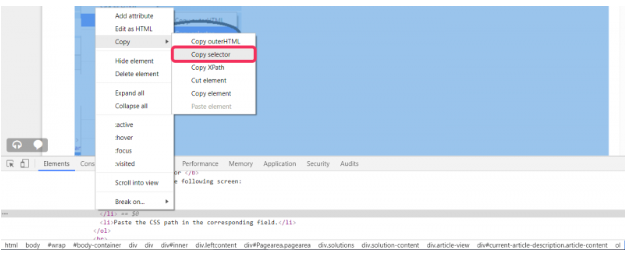
b) Firefox
- Right-click on the element you want to track and select Inspect Element.
- On the Developer tool, right click on the element property and click Copy and CSS Selector.
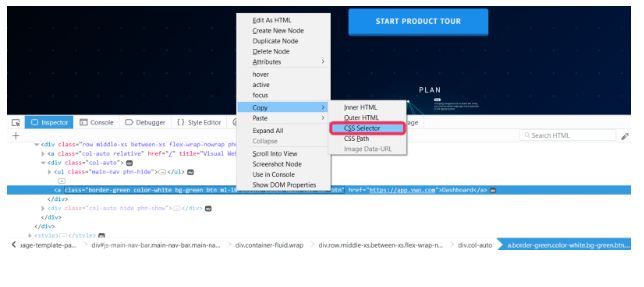
NOTE: The approach used above is only useful if you want to track a specific element in a specific page in a specific position.
If you want to track for example all "add-to-cart buttons" on all pages of your website, you then have to find what is common in all those buttons - id, class, element etc and use that as the CSS selector.
For example, if you want to segment subscribers who click on the "Submit" button as shown below, you can find out the CSS path of the "Submit" button by following the steps mentioned above.
The path of the element (log-btn), in this case, is highlighted in red. Paste this in the CSS selector field in the segment creator as shown below: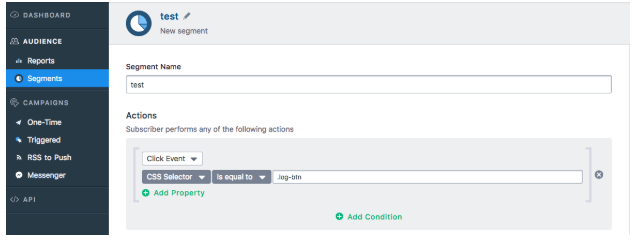
Note: The "dot" before the element (log-btn) in the screenshot above represents the selector pattern (.class). This simply means that all the elements with "Class=log-btn" will be selected.
Below are some other selector patterns that you can use:
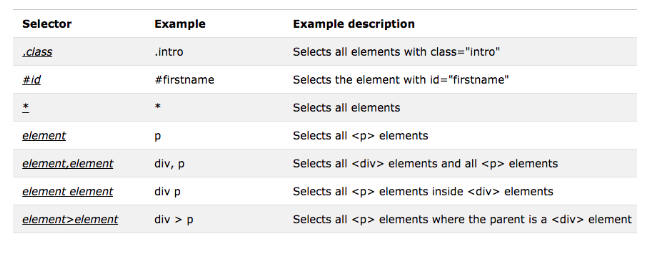
Note: The VWO Engage code must be present on all pages of the elements selected.
You can create a segment using a specific CSS selector along with other properties such as URL visited or Time of the day. Below is an example of how such a segment would look like:
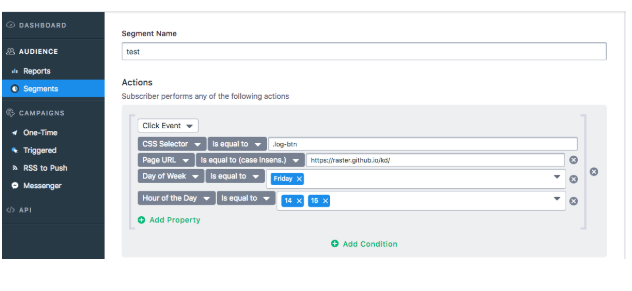
The screenshot above represents a segment in which a subscriber will be added when he lands on the URL https://raster.github.io/kd/ on Friday between 14:00hours and 15:59 hours and clicks on the Button with the ID #linkbutton present on the URL.
NOTE: PageURL attribute inside the Element Clicked event denotes the URL on which the button/link is present.
If you want to segment based on a button/link click which redirects to a different URL, it will only work if the redirect url belongs to the same domain.
9) Once the segment is created, it might take up to few minutes for the segment to populate with subscribers if you have a lot of subscribers matching the segment condition and once the process is done you would receive an email regarding the same. Also, segments are dynamic in nature hence as your subscriber count increases the segment creator would evaluate them and put them in the appropriate segment.
NOTE: Segments once created cannot be edited and it can only be deleted.
10) Once your segment is ready, Craft your notification and check the segments you want to send the notification.

NOTE: You can send a notification to 20 segments at a moment. If there are common subscribers in the selected segments, the system will always select only unique subscribers and send only one notification to that subscriber.
